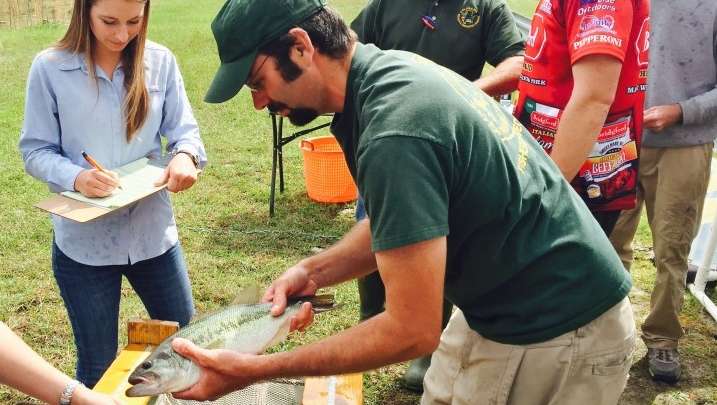
The weights of the bass that graced the scales on Friday proved what everyone already knew about the spotted bass fishing on Smith Lake, site of the Bass Pro Shops Southern Open #2.
The spotted bass are fatter than ever and the fishing is incredible. The reason?
Blueback herring. The illegally-introduced baitfish is an exotic species that spells good and bad news for lakes where they don’t belong. That’s why the Alabama Department of Conservation and Natural Resources is closely watching the influence of bluebacks on Smith Lake.
The Open is another indicator of how good the spotted bass fishing is on the central Alabama fishery.
Fifteen-pound limits of mostly spotted bass are common in local tournaments. Friday was no exception at the Open, with spotted bass accounting for most of the limits caught.
Blueback herring add more food, grow bigger spotted bass and make fishing better for Alabama’s prized freshwater game fish. What could be wrong with that?
“Blueback herring are eating from the foundation of the food chain,” explained Jay Haffner, ADCNR district fisheries supervisor for the area. “That’s what concerns us most.”
Bluebacks compete for food with native gizzard and threafin shad that form a foundation of the food chain. That includes zooplankton, other microscopic organisms and insect larvae.
A concern is the bluebacks could eventually crowd out the native shad supporting the overall fishery. The domino effect can tip the scales the opposite direction and put the entire ecoystem of a lake in jeopardy. If the bottom falls out then everything above suffers, including the spotted bass.
Conservative estimates of the blueback population are in the millions. Bluebacks are reaching critical mass and show no sign of slowing. Spotted bass and striped bass are getting fatter. Other species, specifically largemouth bass and panfish, are not.
That’s because bluebacks share the same water column as spotted bass and striped bass.
Biologists aren’t concerned just yet.
“Life is good right now for spotted bass and striped bass on Smith Lake,” said Haffner. “We’ve seen no reason for alarm due to a breakdown in the food chain.”
State-funded research is underway at Auburn University to study what might happen next. Three years into the study the prognosis is good, although the lake is at a critical stage.
“The bad news is the timing of the blueback herring introduction might be early in our research,” said Haffner. “We need more time to see any negative changes.”
Auburn scientists will continue watching for signs over the next three years. That’s when more evidence will support the impacts of blueback herring in the lake.
The bluebacks are cause for concern – or not – elsewhere in Alabama, too. Smith Lake’s elevation jumped 17 feet in December after heavy rains. The spillover sent bluebacks into the Black Warrior River where they were spotted near Tuscaloosa.
Haffner noted striped bass are getting caught deeper than ever before in Smith Lake. Following the blueback herring into deeper water is the suspected reason. That could mean the same trend for spotted bass, although that’s just speculation right now.
What’s no longer a question is how the blueback herring invaded Smith Lake.
Michael L. Perry, 35, of Jasper, Ala., and James M. Banks, 58, of Crane Hill, were charged with illegal importation and sale of blueback herring. Law enforcement officers caught the men in August 2015 during checks of commercially licensed guide boats.
An investigation revealed that Perry imported thousands of blueback herring annually from Georgia. The men face possible jail time in addition to large fines.
In the meantime, the spotted bass fishing continues getting better. Only time will tell for how long.

